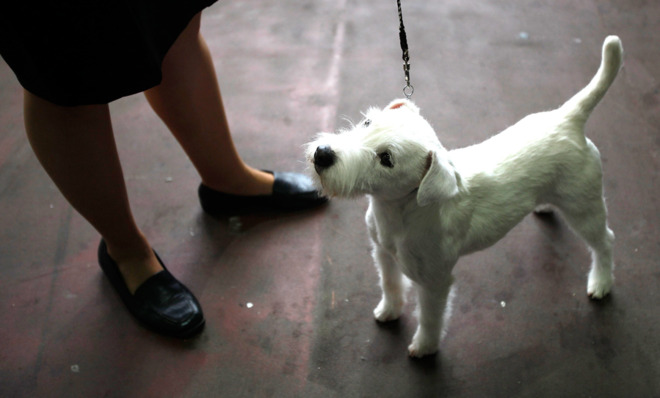Decoded: What dogs are trying to say when they wag their tails
Shocker: It's not always "I'm happy!"

My first dog, Bubsy, a large-ish mutt of indeterminable origin, would get really excited whenever I reached for an orange rubber ball. I would throw it, she would dutifully retrieve it and drop it at my feet, and the process would repeat until I got bored. (She never did.)
Once in a while, I would tease her and pretend to throw it, causing her feather duster of a tail to whack back and forth in great swoops like a clumsy fan. This had the unfortunate side effect of, depending on where we were, knocking over whatever happened to be in her nearby vicinity: Gardening tools, young children, red plastic cups — the usual.
I always assumed, based on Bubsy's non-stop tail, that she was just always excited. A happy go-lucky beast. But new research suggests that it's actually more complicated than that. In a new study published in the journal Current Biology, a team of Italian researchers had the ho-hum task of observing adorable dogs. In this case, the dogs were shown videos of other dogs wagging their tails, and their emotional reactions were recorded accordingly.
The Week
Escape your echo chamber. Get the facts behind the news, plus analysis from multiple perspectives.

Sign up for The Week's Free Newsletters
From our morning news briefing to a weekly Good News Newsletter, get the best of The Week delivered directly to your inbox.
From our morning news briefing to a weekly Good News Newsletter, get the best of The Week delivered directly to your inbox.
The team's goal, in this case, was to determine if the direction the pups were wagging their tails conveyed different meanings indiscernible to humans, at least at face value.
Perhaps unsurprisingly, they did. The New York Times reports:
When watching a tail wag to the left, the dogs showed signs of anxiety, like a higher heart rate. When the tail went in the opposite direction, they remained calm. [The New York Times]
The reason for this, says researcher Giorgio Vallortigara, a neuroscientist at the University of Trento, is that dogs, like their human counterparts, have asymmetrically organized brains. "The emotions are associated presumably with activation of either the right or left side of brain."
Makes sense. A left-brain activation produces a wag to the right; a right-brain activation produces a wag to the left.
A free daily email with the biggest news stories of the day – and the best features from TheWeek.com
Only, again, it's not quite that simple. The recent findings build on previous research, which suggests dogs use tail-wagging as a way to communicate in the same way we use our smiles. Of course, we smile for all sorts of reasons beyond the overarching umbrella of "happy": We smile when we're merely being polite; when we're trying trick a potential romantic entanglement that we're, like, totally dateable; when we're in an awkward public situation and not sure what to do with our hands, etc.
Dogs may use their tail wags in much the same way.
The tail's position-specifically, the height at which it is held-can be considered a sort of emotional meter. A middle height suggests the dog is relaxed. If the tail is held horizontally, the dog is attentive and alert. As the tail position moves further up, it is a sign the dog is becoming more threatening, with a vertical tail being a clearly dominant signal meaning, "I'm boss around here," or even a warning, "Back off or suffer the consequences." [Psychology Today]
And, just like there are dialects for human language — a rapid-fire Brooklyn accent has very different characteristics from a slow, southern drawl, for instance — the tail wags of different breeds have different subtle tics.
As Psychology Today's Stanley Coren notes: "Different breeds carry their tails at different heights, from the natural nearly vertical position common to Beagles and many Terriers to the low-slung tails of Greyhounds and Whippets."
As for Bubsy, who is probably wearing sausage links around her neck in Doggy Heaven right now, I'll just assume she was happy all the time, and not upset I wouldn't throw her her favorite ball.
-
 ‘Capitalism: A Global History’ by Sven Beckert and ‘American Canto’ by Olivia Nuzzi
‘Capitalism: A Global History’ by Sven Beckert and ‘American Canto’ by Olivia NuzziFeature A consummate history of capitalism and a memoir from the journalist who fell in love with RFK Jr.
-
 Who will the new limits on student loans affect?
Who will the new limits on student loans affect?The Explainer The Trump administration is imposing new limits for federal student loans starting on July 1, 2026
-
 Why does Susie Wiles have MAGA-land in a panic?
Why does Susie Wiles have MAGA-land in a panic?TODAY’S BIG QUESTION Trump’s all-powerful gatekeeper is at the center of a MAGA firestorm that could shift the trajectory of the administration